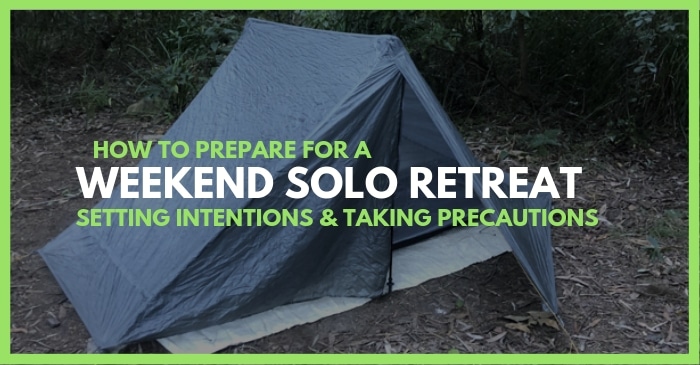You’ve reached a point in your life where you’re looking for change. You wish to create space for something new. Maybe a big decision looms but you aren’t sure what to do. Maybe you‘re a meditator and you’ve become too dependent on formal retreat centers and wish to regain your independence and sit outside in nature. Whatever the reason, going out on a solo retreat can help you access the clarity you seek. Going on a solo retreat can be much simpler and much more accessible than you might first imagine.
Today we’re going to walk through how you should go about preparing for your upcoming solo weekend retreat and how to get the most out of it.
Set your intentions
Before you move into planning, ask yourself what you’d like to get out of doing a solo retreat.
I enjoy dividing my intentions into categories: mental, physical, and spiritual (and anything else you’d like insight into) with an overarching intention.
Write as much as you’d like and be as specific as possible. Having a why will help you persevere in times of difficulty and ensure you get the most of your time spent alone.
Close any outstanding loops
Ask yourself if there are any important loops you need to close that make leaving a comfortable experience. There will always be tens or hundreds of loops that keep you from your solo retreat—pick only the top one or two loops that if not taken care of prior to your trip would consume your attention and drive you mad. The rest can be left aside for the weekend.
Select a campsite

In my opinion, the best place to stay is in nature, has access to a water source, and is mostly unpopular. That being said, do not by any means feel as if you have to go to some far-off place. It doesn’t even have to be more than a mile out from a parking lot near nature. It can even be in a friend’s backyard! The most important thing is that you choose somewhere that is comfortable for you. That said, I highly recommend your solo retreat be set in an environment that is new to you. Realize that the further out you are, the greater chance you have of being alone and being able to focus clearly.
Know the terrain

If you choose a campsite that’s foreign to you and a good hike out from any roads, purchase topographical maps for the hike in and out, just in case. These are usually a bit expensive ($20) but you’ll want them to feel fully prepared and to use them if you need them. If you find this necessary, do a bit of research into understanding how to read topography.
Also, make sure you download two navigation apps: Google Maps and Maps.me. I use Maps.me all the time for hiking and camping. They are offline maps that can be downloaded in town and used without service while on the trail. Zoom into the location of your campsite and download the maps for that region.
Have a water plan

Unless you are dry fasting, having adequate and accessible water is an essential part of your retreat and it’s best if you’ve got this squared away beforehand so your mind isn’t worried. It’s best if you find a camping spot next to a reliable water source, and you can bring a filter to last you the retreat. If I had so say a number, I’d recommend at least a minimum of one to two liters of water per day. It all depends on your body and mind, how many miles of hiking to be done, and whether the sun’s out or not.
Set a Date and check the weather
Pick a day and stick to it! Check the forecast in that area and be sure you aren’t entering into danger on the weekend of your retreat. Allow yourself the flexibility of rescheduling or even an entire backup plan in case the original site falls through.
Pack properly

It’s essential to fine-tune your packing strategy as best as you can before you head out. You’ll need to bring full hiking and lightweight camping gear. Do not pack more than you need and do not forget anything that you need. Check out my video of what I brought to my trip to Nepal to get a good look into the necessary gear, or reach out with any questions.
Bring your phone
Even though you’ll be “retreating,” bringing a smartphone is an essential item for navigation, note-taking, setting alarms, documenting, emergencies, and whatever else you desire. Just be aware of the potential distractions you might fall into and make a strong determination you won’t give in. Make sure to turn off cell reception while you are retreating.
Bring a power bank
This device ensures your phone’s battery stays alive for many days. Anchor is a great brand to research. Mine allows around six or more full charges for my iPhones, which is plenty of battery to last me for a multiple-day retreat.
Final Precautions
It’s important that you inform a close friend or family member of your intentions, meaning where you expect to be and how many days you expect to be gone. This way, in the likely small chance that something happens to you, there is the option that you’ll be alright. Another option is to declare your intentions to a local police station. Some of them offer beacons, which can be used in emergency situations. Depending on your outdoor experience and the destination you’ve chosen for your solo retreat, you might want to purchase one for yourself.
Release Expectations
This one is self-explanatory. Despite all your best efforts with intention-setting, you May run into a variety of challenges along the way to or during your solo retreat. For instance, upon arrival, there might be people camped there along with you. Do your best to adapt to all situations that might be out of your control to make the most out of your time spent alone.

Wishing you a fruitful solo retreat! I hope you enjoyed the read. If you did, please share it with a close friend and consider following the journey:
Wishing you well.
Love,
David
PS — thanks to my patrons who support my work.
PSS — you can purchase my hiking memoir, The Trail Provides, on Amazon and Audible today.





Leave a Reply
I guarantee 100% privacy. Your information will not be shared.